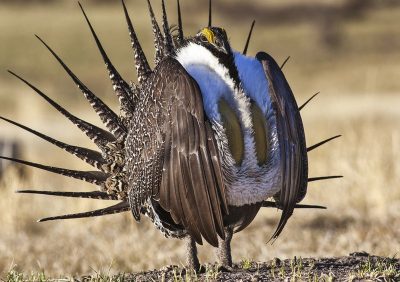Trump Administration Recycles Slashing of Sage-grouse Protections, Opening Habitat to Drilling, Fracking Across Seven Western States

The Trump administration unveiled its final analysis today to justify its 2019 land-management plans that slashed protections for the imperiled greater sage grouse across 51 million acres of the western United States.
Today’s final “supplemental environmental impact statements” covering Bureau of Land Management lands across California, Idaho, Wyoming, Nevada, Oregon, Utah and Colorado are intended to prop up earlier plans blocked by a federal judge in Idaho in October 2019.
“Trump’s Bureau of Land Management doesn’t seem to get that they can’t just paper over their mistakes in failing to protect sage-grouse habitat,” said Erik Molvar, executive director with Western Watersheds Project. “Instead of strengthening sage-grouse protections as scientific principles and sage grouse population declines would dictate, this administration continues to make excuses for slashing protections, with additional excuses and denials of the impacts of its decisions on sage-grouse habitat.”
“These guys are hellbent on turning over the last refuges of the vanishing greater sage grouse to drilling, mining and grazing,” said Michael Saul, a senior attorney at the Center for Biological Diversity. “It’s disgusting, transparent and illegal. The Trump administration isn’t even trying to repair the scientific and legal failings of its 2019 cuts to sage-grouse habitat protections. Instead it’s doubling down on pandering to extractive industries and steamrolling over conservation science.”
The new environmental analysis is the latest chapter in the greater sage-grouse conservation saga. To prevent Endangered Species Act listing for the sage grouse in 2015, the Obama administration issued land-use plan amendments to improve protection for the bird across much of the West, including parts of California, Idaho, Montana, Nevada, Oregon, Wyoming, Colorado, the Dakotas and Utah. The Obama-era amendments relied heavily on loophole-ridden, optional conservation measures, which the Trump administration has tried to further weaken.
“If the BLM were serious about improving its plans, it would have done so last year when we provided extensive comments and scientific support telling them what they could do better,” said Lindsay Larris, wildlife program director with WildEarth Guardians. “It’s unfortunate but likely that the agency only intends to do the bare minimum to get its pro-industrial extraction plan back in effect.”
In 2019 the Bureau issued new plan amendments that further weakened protections and benefited the fossil-fuel industry — even as the bird’s remaining populations dwindled. Months later a federal judge blocked the plan, citing the Bureau’s numerous violations of the National Environmental Protection Act. Rather than redo its analysis, the Bureau simply created today’s supplemental environmental impact statements to “clarify” its analysis and support its earlier conclusions.
“The administration’s last-minute attempt to save BLM’s plan amendments will fail in court,” said Sarah Stellberg, an attorney with Advocates for the West, which is representing the conservation groups. “Rather than remedy its NEPA violations, the Bureau just doubled down on its prior unlawful analysis.”
Greater sage grouse once occupied hundreds of millions of acres across the West, but their populations have plummeted as oil and gas extraction, livestock grazing, roads and power lines have destroyed and fragmented their native habitats.
The grouse is under threat because it’s intensely loyal to particular areas, reliant on large expanses of intact sagebrush and especially sensitive to disturbance and habitat fragmentation. It also needs enough vegetation cover and nutrition to raise chicks, unaltered mating grounds called “leks” for reproduction, and sufficiently healthy winter habitat to survive the cold season.
Protecting the grouse and its habitat benefits hundreds of other species that depend on the Sagebrush Sea ecosystem. That includes pronghorns, elk, mule deer, golden eagles, native trout and migratory and resident birds. The Bureau of Land Management is responsible for managing about half of the nation’s remaining sage-grouse habitat.
Even as the Trump administration rolled out its latest effort to weaken sage-grouse protections, Congress is debating whether to extend a six-year moratorium on listing the greater sage grouse.
“Now, more than ever, it is obvious that sage grouse need the safety net of the Endangered Species Act,” said Molvar.
*
Note to readers: please click the share buttons above or below. Forward this article to your email lists. Crosspost on your blog site, internet forums. etc.
Featured image: Greater sage grouse. Photo credit: Bob Wick, BLM Image is available for media use.

